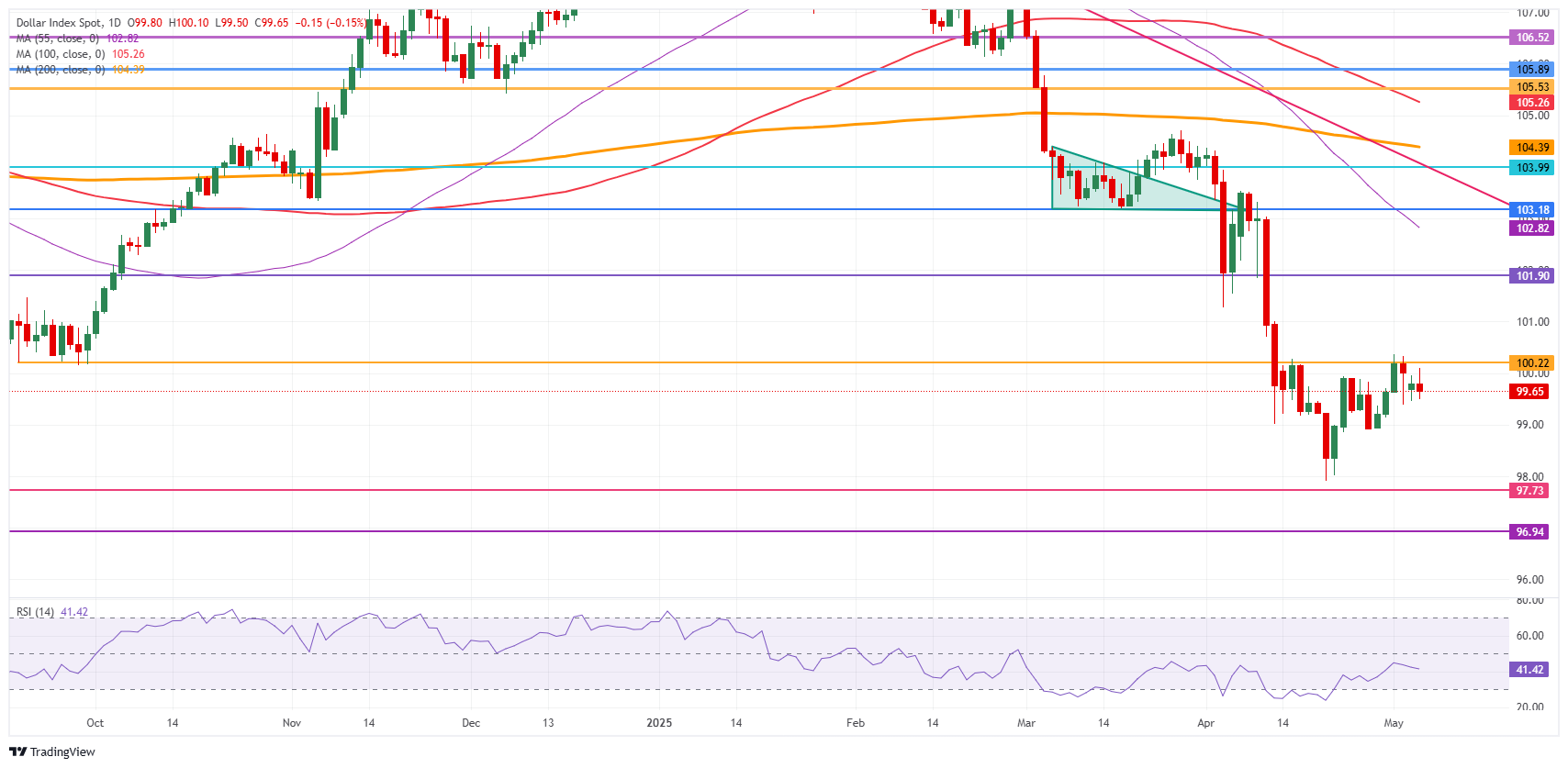- The American dollar index lowers slightly, although the daily range narrows.
- Traders are evaluating the risk of spreading the increase in the Taiwan dollar on Monday to other currencies in the region.
- The American dollar index remains limited below 100.00, still caught in a waiting range.
The American dollar index (DXY), which tracks the performance of the US dollar (USD) compared to six main currencies, goes down while catching in a very narrow range on Tuesday. Market participants are evaluating the recent sudden movement in the Taiwan dollar (TWD), which was appreciated more than 5% against the US dollar on Monday before somewhat backed up on Tuesday. The markets are trying to evaluate whether a contagion effect could occur, affecting larger Asian currencies such as the South Korean won (KRW), the Japanese Yen (JPY) or the Chinese Renminbi (CNH).
Meanwhile, in the Geopolitical Front, a torrent of headlines is reaching the markets, being the most recent the fact that the next German chancellor Friedrich Merz failed to obtain a majority in the vote of the German Parliament to become the new chancellor. On the other side of the Atlantic, the US Secretary of Commerce Howard Lutnick increased the bets for the Trump administration to deliver an initial commercial agreement soon, saying that the first agreement must be with an economy of “Top Ten”, he said in Fox News. In Europe, the war between Russia and Ukraine is intensifying with drone attacks on both sides, while Israel prepares even more for a land offensive with the aim of completely controlling the Gaza Strip.
What moves the market today: slow data before the Fed
- At 12:30 GMT, the US trade and services balance will be published for March. A broader deficit of 129,000 million dollars is expected compared to the deficit of 122.7 billion dollars in February.
- The actions are very varied, since several countries in Asia remain closed for a holiday. European indices rise around 0.50% in the day, while US futures seem to be under pressure with NASDAQ by lowering about 1%.
- The CME Fedwatch tool shows that the probability of an interest rate cut by the Federal Reserve at the May meeting is 3.2% compared to a 96.8% probability that there are no changes. The June meeting sees a 31.8% probability of a rate cut.
- The yields of 10 years of the US are quoted around 4.31%, deleting the weakening of the previous weeks, since traders have even discounted the possibilities of a rate cut in June.
Technical analysis of the dollar index: internal pressure
The US dollar index (DXY) faces some winds against after the US Secretary of Commerce Lutnick increased pressure from within the Trump administration to achieve an initial commercial agreement. Lutnick added that the initial agreement should be with a Top Ten economy, to establish an example. Despite several statements by US President Donald Trump and several members of the cabinet that the agreements are imminent, real signed trade agreements have not been announced.
On the positive side, the first resistance of the DXY is found in 100.22, which supported the DXY in September 2024, with a rupture above the round level of 100.00 as an upward signal. A firm recovery would be a return to 101.90, which acted as a key level throughout December 2023 and again as a basis for the formation of inverted shoulder-hombro (H&S) during the summer of 2024.
On the other hand, the support of 97.73 could be quickly tested before any substantial bearish holder. Below, a relatively thin technical support is located at 96.94 before looking at the lowest levels of this new price range. These would be 95.25 and 94.56, which would mean new minimums not seen since 2022.

US dollar index: daily graphics
Commercial War between the US and China Faqs
In general terms, “Trade War” is a commercial war, an economic conflict between two or more countries due to the extreme protectionism of one of the parties. It implies the creation of commercial barriers, such as tariffs, which are in counterbarreras, increasing import costs and, therefore, the cost of life.
An economic conflict between the United States (USA) and China began in early 2018, when President Donald Trump established commercial barriers against China, claiming unfair commercial practices and theft of intellectual property by the Asian giant. China took retaliation measures, imposing tariffs on multiple American products, such as cars and soybeans. The tensions climbed until the two countries signed the Phase one trade agreement between the US and China in January 2020. The agreement required structural reforms and other changes in China’s economic and commercial regime and intended to restore stability and confidence between the two nations. Coronavirus pandemia diverted the attention of the conflict. However, it is worth mentioning that President Joe Biden, who took office after Trump, kept the tariffs and even added some additional encumbrances.
Donald Trump’s return to the White House as the 47th US president has unleashed a new wave of tensions between the two countries. During the 2024 election campaign, Trump promised to impose 60% tariff particularly in investment, and directly feeding the inflation of the consumer price index.
Source: Fx Street
I am Joshua Winder, a senior-level journalist and editor at World Stock Market. I specialize in covering news related to the stock market and economic trends. With more than 8 years of experience in this field, I have become an expert in financial reporting.






